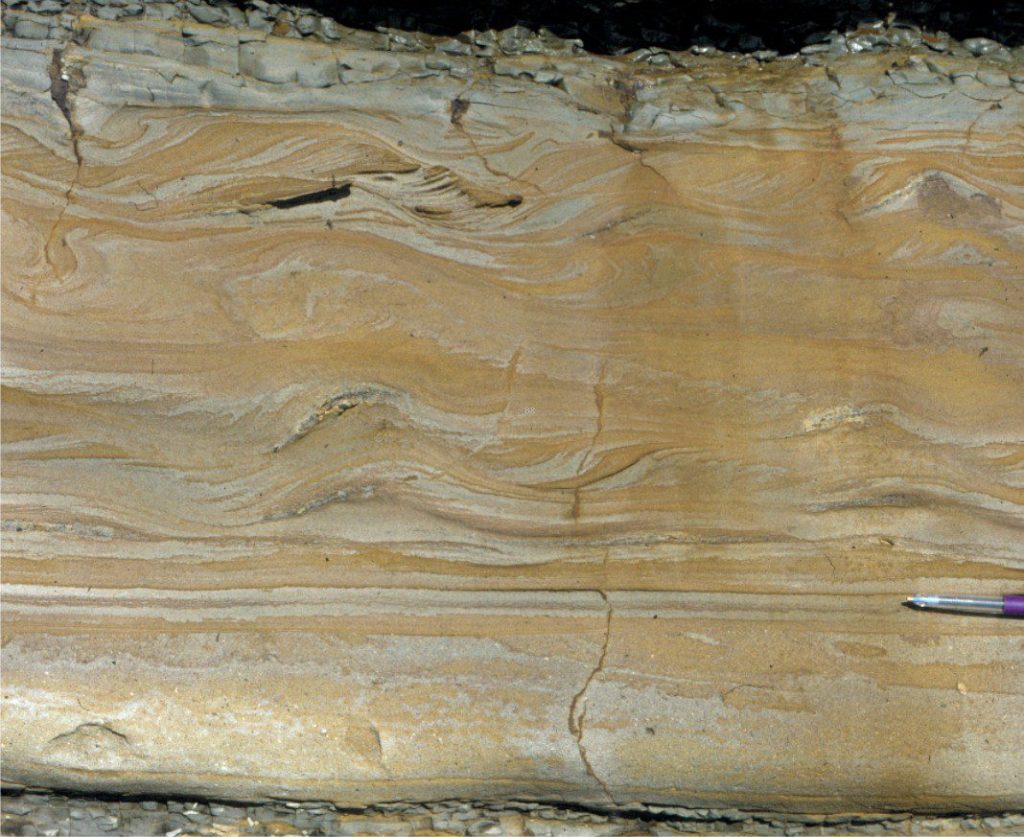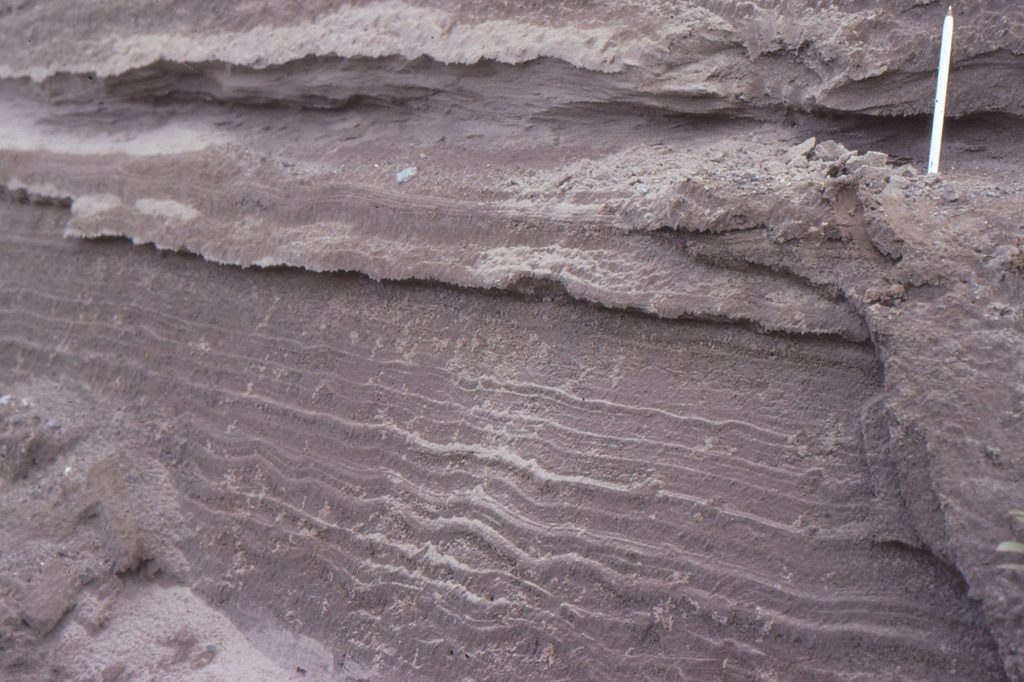

Climbing ripples in a turbidite – indicators of high suspension sediment load combined with bedload.
Use this link to read the introduction to the lithofacies series.
General occurrence:
Also called ripple drift. A typical climbing ripple profile is manifested as ripple crossbed sets migrating over the upstream, or stoss face of earlier-formed ripples. They form where there is a combination of bedload and suspended load deposition of fine-grained sand. Climbing ripples are one of the few bedforms that preserve stoss-side laminae.
External form:
Climbing ripples can have asymmetric and symmetric profile, depending (at least in part) on the ratio of bedload to suspension load deposition. The view across a depositional surface will show a succession of crossbed sets where upstream ripples migrate over their downstream counterparts. Amplitudes and wavelengths are similar to asymmetric current ripples formed in clear water conditions.
Internal structure and hydraulic conditions:
Climbing ripples have a distinctive internal configuration that, depending on depositional conditions, is manifested in two basic morphological types: ripple sets with lee-face foresets only, and combinations of lee-face and stoss-face laminae – there are several variations on these two end-members. The climbing ripple classification schemes in common use were proposed by Jopling and Walker (1968 PDF available) and Allen (1973 PDF available), and are summarised in the diagram below.


Classification and interpretation of the climbing ripple geometric and hydraulic spectrum from Jopling and Walker, 1968 (left), and Allen, 1992, Fig. 4.24 (right).
Climbing ripples ‘climb’ because a suspended sediment load is added to the bedload as ripples advance downstream. The angle of climb is proportional to the change in suspended load – an increased suspension load leads to increased angles of climb. Climb angles measured from the substrate commonly range between 10o – 20o. Type 2 climbing ripples of Jopling and Walker are characterized by preservation of lee face laminae in crossbed sets bound by an erosional base/top. Allen, based on flume experiments and numerical modelling, designated the flow conditions in this type of climbing ripple as subcritical where erosion continually moves sediment from the stoss face to the lee face. The direction of ripple migration is the same as the direction of foreset dip.
At the other extreme, in phase climbing ripples preserve both stoss and lee face laminae in supercritical flow conditions. Here, the thickness and lateral continuity of individual laminae are maximized. For this type, deposition from suspension exceeds the potential for erosion over the stoss face, which means the stoss face is preserved.
In between these two types there is a spectrum of climbing ripple geometries that display variations in laminae thickness and lateral continuity, angle of climb, and grain-size segregation within crossbed sets and cosets. All these variables reflect systematic changes in the ratio of bedload to suspension load. Outcrops of climbing ripples commonly show the evolution of one type to another, depending on changes in current strength and suspension load sediment.
An example of the transition in climbing ripple morphology is shown in the photo below where the steeper angle of climb in the upper Type 2 (subcritical) coset indicates an increase in the suspended sediment load compared with the lower coset, even though stoss-side erosion still took place. In both cosets only the lee face laminae are preserved.


Two cosets of Type 2 – subcritical climbing ripples (separated approximately by the pen) – the upper coset having steep angles of ripple climb, the lower coset much shallow inclinations; illustrated graphically in the sketches. The top coset migrated left; the lower coset to the right. The deposit is part of an Eocene succession of relatively coarse-grained, low sinuosity channels. The climbing ripples are inferred to have formed on a sandy bar-top during the waning stages of a river flood. Axel Heiberg Island, Arctic Canada.


In-phase (supercritical) climbing ripples in the lower part of this outcrop pass upwards to more laminated fine-grained sands where ripples are barely evident. Late Pleistocene glaciofluvial deposits near Vancouver, Canada.
Common environments of deposition:
Climbing ripples form when the sediment bedload is augmented by a significant volume of sediment fallout from suspension. High suspension loads are characteristic of flood conditions in rivers and alluvial fans where sediment is released from suspension as the flood wanes. Similar conditions arise where river flood waters break from the channel margin and spread across an adjacent floodplain, or where channels enter a standing body of water such that there is an abrupt decrease in bottom current velocity and turbulence.
Climbing ripples are also common in turbulent sediment gravity flows such as turbidity currents where sediment in suspension falls to the accreting bed as turbulence wanes. These bedforms define the ‘C’ division of Bouma turbidite flow units.


The turbidite here is a compound unit with an erosional discordance between two B division sandstones. The C division contains a complex array of climbing ripples – ripples near the base are either in-phase or transitional between in-phase and drift phase. The upper ripple sets are mostly drift-type (Type 2 of Jopling and Walker). This suggests a decrease in the suspended sediment load where the upper Type 2 sets indicate a higher ratio of bedload deposition. From the Lower Miocene Waitemata Basin, Auckland.


The C- division in this turbidite contains climbing ripples that are mostly transitional where there is some stoss-face preservation, but also maintain a strong down-flow orientation of lee-face foresets. From the Lower Miocene Waitemata Basin, Auckland.
Other posts in the Lithofacies series
Sedimentary lithofacies – An introduction
Ripple lithofacies: Ubiquitous bedforms
Ripple lithofacies influenced by tides
Tabular and trough crossbedded lithofacies
Laminated sandstone lithofacies
Other posts that provide useful background information on bedforms and processes include:
Crossbedding – some common terminology
Sediment transport: Bedload and suspension load
Fluid flow: Froude and Reynolds numbers
The hydraulics of sedimentation: Flow Regime
Laminated sandstone lithofacies
Low-angle crossbedded sandstone
Hummocky and swaley cross-stratification
Lithofacies beyond supercritical antidunes
Subaqueous dunes influenced by tides
Introducing coarse-grained lithofacies
